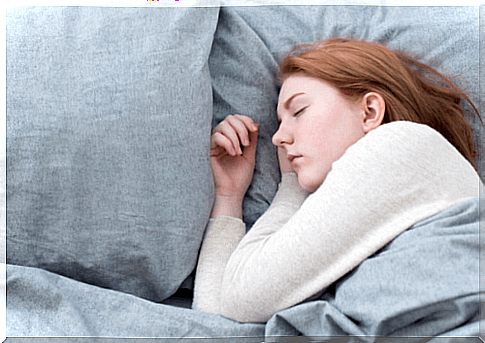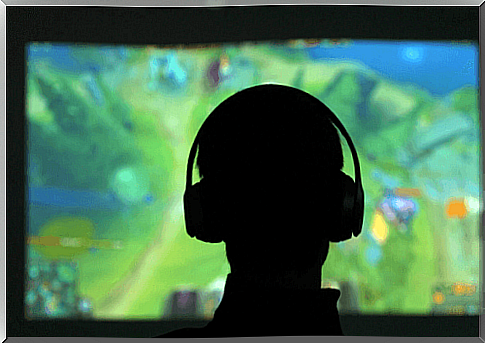Adolescents And Sleep: Biological Principles

For many parents, sleeping until noon means laziness and negligence. They wonder why their teenagers sleep so much; they think it means they have no ambitions and throw their lives away. In addition, excessive sleep is often linked to other behaviors teenagers display. For example, not tidying up your room.
Laziness is something that can make parents quite angry. Even more so when their children complain when their mother or father tries to wake them up before noon. With uncombed hair and pillow stains on their faces, the teens loll to the table for family dinner while moody and irritable.
What many parents don’t know, however, is that getting more sleep is perfectly normal for teenagers . Various studies show that it is part of a series of imbalances in this particular phase of life.

Testosterone, Teens, and Sleep
Hormonal increases change, among other things, the sleep cycle of the adolescent man. His brain is reprogrammed around the age of 11 or 12, and the testosterone receptors change their circadian rhythm. As a result, the male teenager goes to bed later and gets up later. So sleeping until noon has nothing to do with rebellion or laziness, but with the hormonal activity of the body.
Estrogen, Adolescents, and Sleep
Just like testosterone in boys, estrogen in girls also shakes their emotions, cognition, and body in a number of ways, including sleep. Estrogen receptors are activated in brain cells and act on the suprachiasmatic nucleus. These receptors organize the rhythms of hormones, mood, sleep and temperature.
However, estrogen doesn’t just affect the brain cells that control breathing. It also activates the rhythm of sleep and growth hormones in growing women. Girls begin to change their sleep patterns between the ages of eight and ten.
Technologies, youth and sleep
In addition to hormones, the use and abuse of technology is another factor that contributes to changing the daily rhythm. There are already numerous studies on the use of cyber technologies in relation to computer and console games. Teenagers spend a lot of time playing games on the consoles or on the computer. In addition, these games are known to cause disorders that can range from addiction to attention deficit disorder.
After school and homework, teenagers in their cyberspace world often stay up late into the night. At the same time, many students have to get up early in the morning to attend classes in their school. That means they only get a few hours of sleep each night (around six hours). However, at this stage of their growth, they need at least ten hours.
This would suggest that schools should start classes later, as teens tend to get up later (due to their chronobiology, not computer use) in order to make learning more effective.
Computer games
Computer games are exciting and competitive, with lots of color and action. They encourage the teenagers to keep going until they either defeat their opponent or clear a level. In short, this type of technology gets your adrenaline, cortisol, and dopamine high. Together they ensure a sense of achievement, energy and pleasure.
Adrenaline speeds up our reflexes and enables us to react quickly. Cortisol keeps us awake and active. And dopamine affects the way we seek pleasure and rewards.
These computer games are played under artificial light. This lowers the amount of melatonin, which is important for the induction of sleep. Because of this, teenagers don’t feel the need to go to sleep when they should.
There is also something else to consider. Young people, regardless of their gender, do not know their own limits. As a result, they often fail to realize when to stop playing or surfing the internet to rest.
Parents should set boundaries and guidelines for their children. They should also explain to them how to use video game consoles and computers safely.
Sleep regulation and the pineal gland
The suprachiasmatic nucleus is the center that regulates the circadian rhythm with melatonin via the pineal gland. The pineal gland is a group of neurons from the medial hypothalamus.
The suprachiasmatic core forms our internal or endogenous clock. This receives information about the ambient light through the eyes, more precisely via the retina. It contains PRs that distinguish shapes and colors. It also contains ganglion cells, which contain a pigment called melanopsin. And these forward information via the retinohypothalamic tract to the suprachiasmatic nucleus.
The suprachiasmatic nucleus absorbs this information via the external light-dark cycle. He interprets them and then sends them to the ganglion of the upper cervical spine. From there, the signal is passed on to the pineal gland, which in response releases the hormone melatonin. Melatonin secretion is low during the day and increases at night.
Melatonin and serotonin
Serotonin is the precursor hormone to melatonin. Serotonin is a neurohormone of well-being and relaxation. So when we’re relaxed and happy at the end of the evening, melatonin can work better.
However, if we find ourselves in a stressful situation instead , cortisol will make it difficult for us to fall asleep. This is because cortisol has the opposite effect of serotonin and slows down the production of melatonin. In this sense, the excitement of video games keeps teenagers from sleeping.

Brain waves and sleep in childhood and adolescence
Research shows that by the age of nine, girls ‘and boys’ brainwaves are identical during sleep. However, by the age of 12, changes in girls’ brain waves during sleep are 37% greater than that of boys (Brizendine, 2006).
The scientists concluded that girls ‘brains develop faster than boys’ brains. Campbell points out that the extra synapses in girls’ brains break down earlier than boys. As a result, their brain circuits mature faster.
Another important detail is what sleep specialists refer to as circadian rhythms. They are in the context of the effects of cortisol.
- On the one hand, there is the “ Lark ” sleep type , whose daily rhythm helps you to naturally get up early every day. These are the people who have a hard time staying up late and partying.
- On the other hand, we have the (night) owls that can sleep until noon or even longer. They become active at night and stay awake for hours.
Sleeping until noon (or longer) isn’t always due to laziness
With this in mind, it can be seen that teens do not always sleep through laziness until noon or even later. In fact, there are biological reasons at play here that cannot be avoided.
On the other hand, some teenagers also tend to be lazy and irresponsible. As a result, not everything can be traced back to hormonal imbalances, owl rhythms, or nocturnal technology use.
So it is really important to look at each situation individually. Depending on the cause, the parents can decide whether they want to set limits for the child in the use of technology or not.
Sleeping until (after) noon is not a juvenile crime, and certainly not if it only happens occasionally. However, if it happens repeatedly or continuously, it is important to find the cause and take appropriate steps.









